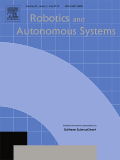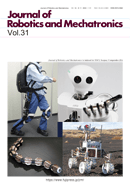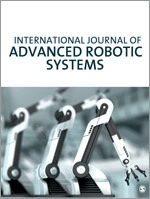
INTERNATIONAL JOURNAL OF ROBOTICS & AUTOMATION
Scope & Guideline
Unleashing Potential in Automation and AI.
Introduction
Aims and Scopes
- Robotics System Design and Control:
This area encompasses the design, modeling, and control strategies of various robotic systems, including manipulators, mobile robots, and autonomous vehicles. Methodologies often involve advanced control algorithms, optimization techniques, and adaptive control strategies. - Sensor Integration and Perception:
Research in this scope focuses on integrating sensors such as Lidar, cameras, and inertial measurement units to enhance the perception capabilities of robots. This includes techniques for simultaneous localization and mapping (SLAM), object detection, and environmental understanding. - Path Planning and Navigation:
A significant focus is on developing algorithms for effective path planning and navigation in dynamic environments. This includes optimization techniques, machine learning approaches, and methods for obstacle avoidance in both autonomous and semi-autonomous systems. - Human-Robot Interaction and Collaboration:
This area explores how robots can work alongside humans safely and effectively. Research includes studies on human-robot collaboration, safety measures, and interaction models to facilitate effective communication and task sharing. - Soft Robotics and Flexible Systems:
The journal highlights advancements in soft robotics, emphasizing the design and control of flexible and compliant robotic systems. This includes the development of soft actuators, grippers, and devices that can adapt to various tasks and environments. - Applications of Robotics in Various Domains:
The journal covers applications of robotics across diverse fields such as healthcare, agriculture, logistics, and underwater exploration, showcasing how robotic technologies can solve real-world problems.
Trending and Emerging
- Machine Learning and AI in Robotics:
There is a notable increase in publications utilizing machine learning and artificial intelligence techniques for various applications in robotics, including control, perception, and decision-making processes. - Collaborative and Swarm Robotics:
Emerging themes around collaborative robots (cobots) and swarm robotics are gaining prominence, with research focusing on multi-agent systems that can work together to accomplish tasks efficiently. - Robotics in Healthcare:
Research targeting the application of robotics in healthcare, such as surgical robots, rehabilitation devices, and assistive technologies, is on the rise, reflecting the growing demand for automation in medical fields. - Robotic Solutions for Environmental Challenges:
There is an increasing trend in developing robotic solutions aimed at addressing environmental issues, such as ecological monitoring and disaster response, highlighting the role of robotics in sustainability. - Soft Robotics and Bio-Inspired Designs:
The field of soft robotics, which emphasizes adaptable and bio-inspired designs, is emerging as a significant area of research, showcasing innovations in materials and actuation methods.
Declining or Waning
- Traditional Control Techniques:
There is a noticeable decline in the publication of papers focused on classical control techniques, such as PID controllers, as more researchers are exploring adaptive and intelligent control methods that leverage machine learning and AI. - Static Path Planning Methods:
Research on static or less dynamic path planning methodologies is waning, as the field shifts towards more adaptive and real-time algorithms that can handle complex, changing environments. - Basic Sensor Technologies:
The exploration of basic sensor technologies is decreasing, with a growing emphasis on advanced sensor fusion techniques and intelligent perception systems that integrate multiple data sources for better performance. - Manual and Semi-Automated Robotic Systems:
There is a decline in interest in purely manual or semi-automated systems, with a shift towards fully autonomous robotic solutions that require minimal human intervention. - Low-Level Hardware Design:
The focus on low-level hardware design for robots is declining, as attention moves towards software-driven solutions, integration of AI, and higher-level system optimization.
Similar Journals

ROBOTICS AND AUTONOMOUS SYSTEMS
Leading the Charge in Robotics and Automated Technologies.ROBOTICS AND AUTONOMOUS SYSTEMS, published by Elsevier, is a leading journal in the fields of robotics and automation, providing a platform for the dissemination of high-quality, peer-reviewed research. With an impressive impact factor and a prestigious reputation, this journal is classified in the Q1 category for major fields including Computer Science Applications, Control and Systems Engineering, Mathematics, and Software as of 2023. The journal boasts an extensive archive dating back to 1988, reflecting the evolution of the discipline and fostering innovative research discussions that are crucial for advancements in autonomous technologies. Researchers, professionals, and students are encouraged to contribute to and benefit from the ongoing dialogue within these dynamic fields. Accessible through various academic resources, ROBOTICS AND AUTONOMOUS SYSTEMS stands as a pivotal information source for those dedicated to exploring the frontiers of intelligent systems.

International Journal of Intelligent Robotics and Applications
Unlocking New Possibilities in Robotics and AIInternational Journal of Intelligent Robotics and Applications, published by SPRINGER SINGAPORE PTE LTD, is a pivotal platform dedicated to advancing the field of robotics and artificial intelligence. With an ISSN of 2366-5971 and an E-ISSN of 2366-598X, this journal has established its presence since its inception in 2017, showcasing innovative research and applications up until 2024. The journal aims to foster interdisciplinary collaboration by publishing high-quality articles that cover a broad range of topics from foundational AI concepts to cutting-edge robotics technologies. It holds respectable rankings, positioned in the Q3 category of Artificial Intelligence and Q2 category of Computer Science Applications in the 2023 metrics, and is indexed in Scopus with notable rankings in both computer science disciplines. Although it follows a subscription model, the journal remains committed to facilitating access to groundbreaking research for its audience of researchers, professionals, and students, contributing to the ever-evolving landscape of intelligent robotics.

Industrial Robot-The International Journal of Robotics Research and Application
Connecting Research with Real-World Robotics ApplicationsIndustrial Robot-The International Journal of Robotics Research and Application is a premier academic journal published by Emerald Group Publishing Ltd in the United Kingdom. Since its inception in 1973, the journal has established itself as a critical resource for the advancement of knowledge in the fields of robotics and automation. With an impressive Q2 ranking across several categories, including Computer Science Applications, Control and Systems Engineering, and Industrial and Manufacturing Engineering, it places itself among the top-tier journals in its domain. The journal aims to disseminate high-quality research that addresses contemporary challenges and innovations in robotics, thereby supporting both academic inquiry and practical applications in industry. Researchers, professionals, and students are encouraged to contribute to its mission, as it remains vital for those seeking to engage with the ever-evolving landscape of robotic technologies.

JOURNAL OF INTELLIGENT & ROBOTIC SYSTEMS
Pioneering Research in Robotics and AIJOURNAL OF INTELLIGENT & ROBOTIC SYSTEMS, published by Springer, is a premier interdisciplinary journal that focuses on the rapidly evolving fields of artificial intelligence, robotics, and their applications across various engineering domains. With an impressive impact factor and ranked in the Q1 and Q2 quartiles of multiple relevant categories—including Electrical and Electronic Engineering, Control and Systems Engineering, and Mechanical Engineering—this journal is essential for researchers, industry professionals, and graduate students seeking to stay at the forefront of innovation in intelligent systems. The journal publishes high-quality research articles, reviews, and technical notes that contribute to advancing theory, practice, and the integration of intelligent robotic systems better suited to meet contemporary challenges. Founded in 1988, and with a robust indexing in Scopus, the journal continues to foster scholarly discourse and serves as a critical resource for those passionate about the future of intelligent technologies, despite not currently providing open access options.

Soft Robotics
Unveiling the Potential of Soft Materials in Robotics.Soft Robotics, published by MARY ANN LIEBERT, INC, stands as a leading journal dedicated to advancing the field of soft robotics, which merges insights from artificial intelligence, biophysics, and control systems engineering to innovate in areas such as bio-inspired design, human-robot interaction, and flexible robotics. With a distinguished Q1 ranking in multiple categories, including Artificial Intelligence, Biophysics, and Control and Systems Engineering, this journal places itself at the cutting edge of interdisciplinary research, boasting impressive Scopus rankings that reflect its rigorous scholarship and influential contributions to the scientific community. Although it is not an open access journal, it provides valuable insights and findings for researchers, professionals, and students eager to explore the transformative potential of soft robotics in practical applications. The journal has published continuously since its inception in 2014, and will continue to converge between theory and application through 2024, emphasizing its commitment to expanding the frontiers of knowledge in this dynamic field. For those engaged in the exploration of robotics technologies shaped by soft materials and adaptive mechanisms, Soft Robotics is an essential resource that fuels innovation and discovery.

Journal of Robotics and Mechatronics
Unlocking Potential in Robotics and Mechatronics ResearchJournal of Robotics and Mechatronics, published by FUJI TECHNOLOGY PRESS LTD, stands at the forefront of innovation in the fields of robotics and mechatronics. Since its inception in 1989, this Open Access journal has become a vital resource for researchers, professionals, and students interested in advances that merge technology with mechanical systems, offering critical insights into practical applications and theoretical developments. With a commendable impact factor reflected in its Q2 rankings in both Computer Science (miscellaneous) and Electrical and Electronic Engineering, the journal serves as a platform for disseminating high-quality research and fostering academic collaborations. The journal enjoys wide accessibility since transitioning to Open Access in 2007, allowing for a global audience to engage with groundbreaking findings relevant to both industry and academia. Based in Tokyo, Japan, the Journal of Robotics and Mechatronics aspires to bridge the gap between research and practical implementation, encouraging the exploration of novel concepts and the sharing of scientific knowledge.

Annual Review of Control Robotics and Autonomous Systems
Navigating the Evolving Landscape of Autonomous SystemsAnnual Review of Control Robotics and Autonomous Systems, published by ANNUAL REVIEWS, is a premier, peer-reviewed journal dedicated to advancing the field of control, robotics, and autonomous systems. With its E-ISSN of 2573-5144, the journal is recognized for its high-caliber contributions, evidenced by its Q1 ranking in key categories, including Artificial Intelligence, Control and Systems Engineering, and Human-Computer Interaction. Spanning converged years from 2018 to 2024, it serves as an essential resource for researchers, professionals, and students who seek to stay abreast of the latest developments and methodologies impacting these rapidly evolving fields. The journal does not currently offer Open Access options, which enables it to maintain stringent quality control while ensuring that every issue is packed with scholarly articles that meet the highest academic standards. With a focus on interdisciplinary approaches and cutting-edge technologies, the Annual Review of Control Robotics and Autonomous Systems is poised as a critical voice for scholarly discourse, fostering innovation and collaboration in tackling complex challenges of the modern world.

Intelligent Service Robotics
Pioneering Insights: Where Robotics Meets Intelligent InnovationIntelligent Service Robotics, published by SPRINGER HEIDELBERG, is a leading journal that focuses on the transformative intersection of intelligent systems and robotics, establishing itself as a pivotal resource for researchers, professionals, and students in the fields of Artificial Intelligence, Computational Mechanics, and Mechanical Engineering. With an impressive impact factor reflective of its relevance—featuring a 2023 Q1 ranking in Computational Mechanics and Mechanical Engineering, and Q2 in Artificial Intelligence—this journal disseminates high-quality, peer-reviewed research that propels innovation and application in various engineering disciplines. Operating from its headquarters in Heidelberg, Germany, Intelligent Service Robotics aims to foster a dynamic academic community, encouraging open dialogue and collaboration among thought leaders and emerging scholars alike. The journal invites submissions that provide novel insights and solutions in the rapidly evolving landscape of service robotics, ensuring that it remains at the forefront of scientific discourse. With a converged publication timeline from 2008 to 2024 and robust Scopus rankings, the journal is committed to shaping the future of robotic intelligence and its applications.

International Journal of Humanoid Robotics
Advancing the Future of RoboticsInternational Journal of Humanoid Robotics, published by World Scientific Publishing Co Pte Ltd, is a leading platform for researchers and practitioners in the fields of artificial intelligence and mechanical engineering. With an ISSN of 0219-8436 and an E-ISSN of 1793-6942, this journal has established itself as a significant resource since its inception in 2004. Spanning various topics from robotic design and control to human-robot interaction, it serves a diverse interdisciplinary audience. The journal’s impressive ranking in the Scopus database, positioned in the third quartile for both categories in 2023, reflects its growing impact in the academic community. Although not open access, the journal provides crucial insights that advance the understanding of humanoid robotics and foster innovative solutions to real-world challenges. Researchers, professionals, and students are encouraged to engage with this essential resource as it continues to shape the future of robotics through rigorous scientific inquiry and scholarly collaboration.

International Journal of Advanced Robotic Systems
Pioneering Insights in Automation and AIThe International Journal of Advanced Robotic Systems is a premier academic journal, published by SAGE Publications Inc., dedicated to fostering innovation and research in the rapidly evolving field of robotics. With an ISSN of 1729-8814, this Open Access journal has been providing unrestricted access to cutting-edge research since 2004, making it an invaluable resource for researchers, professionals, and students alike. The journal aims to disseminate high-quality, peer-reviewed articles that cover a wide range of topics, including but not limited to robotic systems, automation, artificial intelligence, and sensor technologies. By promoting interdisciplinary collaboration and encouraging novel approaches, the International Journal of Advanced Robotic Systems plays a crucial role in advancing the frontiers of robotics and ensuring its impactful application across various industries. Engaging with this journal not only keeps you at the forefront of the latest developments but also contributes to the global discourse on robotics and its advancements in science and technology.